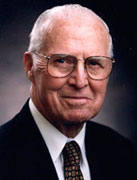Norman Borlaug

Agriculture Scientist
A central figure in the "green revolution", Norman Ernest Borlaug (March 25, 1914- ) was born on a farm near Cresco, Iowa, to Henry and Clara Borlaug. For the past twenty-seven years he has collaborated with Mexican scientists on problems of wheat improvement; for the last ten or so of those years he has also collaborated with scientists from other parts of the world, especially from India and Pakistan, in adapting the new wheats to new lands and in gaining acceptance for their production. An eclectic, pragmatic, goal-oriented scientist, he accepts and discards methods or results in a constant search for more fruitful and effective ones, while at the same time avoiding the pursuit of what he calls "academic butterflies". A vigorous man who can perform prodigies of manual labor in the fields, he brings to his work the body and competitive spirit of the trained athlete, which indeed he was in his high school and college days.
After completing his primary and secondary education in Cresco, Borlaug enrolled in the University of Minnesota where he studied forestry. Immediately before and immediately after receiving his Bachelor of Science degree in 1937, he worked for the U.S. Forestry Service at stations in Massachusetts and Idaho. Returning to the University of Minnesota to study plant pathology, he received the master's degree in 1939 and the doctorate in 1942.
From 1942 to 1944, he was a microbiologist on the staff of the du Pont de Nemours Foundation where he was in charge of research on industrial and agricultural bactericides, fungicides, and preservatives.
In 1944 he accepted an appointment as geneticist and plant pathologist assigned the task of organizing and directing the Cooperative Wheat Research and Production Program in Mexico. This program, a joint undertaking by the Mexican government and the Rockefeller Foundation, involved scientific research in genetics, plant breeding, plant pathology, entomology, agronomy, soil science, and cereal technology. Within twenty years he was spectacularly successful in finding a high-yielding short-strawed, disease-resistant wheat.
To his scientific goal he soon added that of the practical humanitarian: arranging to put the new cereal strains into extensive production in order to feed the hungry people of the world - and thus providing, as he says, "a temporary success in man's war against hunger and deprivation," a breathing space in which to deal with the "Population Monster" and the subsequent environmental and social ills that too often lead to conflict between men and between nations. Statistics on the vast acreage planted with the new wheat and on the revolutionary yields harvested in Mexico, India, and Pakistan are given in the presentation speech by Mrs. Lionaes and in the Nobel lecture by Dr. Borlaug. Well advanced, also, is the use of the new wheat in six Latin American countries, six in the Near and Middle East, several in Africa.
When the Rockefeller and Ford Foundations in cooperation with the Mexican government established the International Maize and Wheat Improvement Center (CIMMYT), an autonomous international research training institute having an international board of trustees and staff, Dr. Borlaug was made director of its International Wheat Improvement Program. In this capacity he has been able to realize more fully a third objective, that of training young scientists in research and production methods. From his earliest days in Mexico he has, to be sure, carried on an intern program, but with the establishment of the Center, he has been able to reach out internationally. In the last seven years some 1940 young scientists from sixteen or so countries (the figures constantly move upward) have studied and worked at the Center.
Dr. Borlaug is presently participating in extensive experimentation with triticale, a man-made species of grain derived from a cross between wheat rye that shows promise of being superior to either wheat or rye in productivity and nutritional quality.
In addition to the Nobel Peace Prize, Dr. Borlaug has received extensive recognition from universities and organizations in six countries: Canada, India, Mexico, Norway, Pakistan, the United States. In 1968 he received an especially satisfying tribute when the people of Ciudad Obregon, Sonora, Mexico, in whose area he did some of his first experimenting, named a street in his honor.